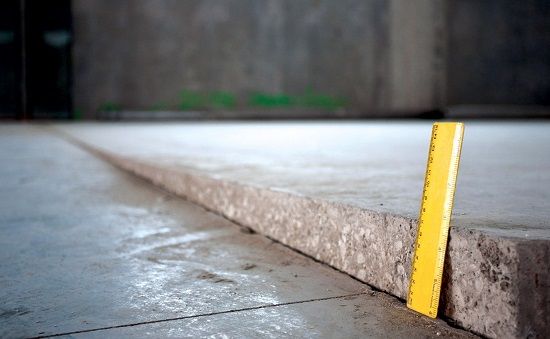Time efficient solutions for lifting large concrete slabs in industrial environments

29 October 2019
Large concrete slabs play an important role in warehousing and logistics environments, where hardstands for loading and unloading heavy road freight trucks and haulage vehicles, and vast storage facilities are essential to core business operations.
If these heavy concrete slabs are compromised in any way, due to underlying issues below ground, it can significantly disrupt business operations, impact equipment performance and load tolerance, affecting the safety of operators and drivers, and raising serious concerns for operations managers.
To avoid service disruptions or, in the worst case, workplace accidents in an environment where heavy vehicles and machinery are common, effective and proactive health and safety management is crucial, including looking out for less obvious hazards as well as the obvious ones.
For example, early signs of sloping or sinking transport yard pavements and driveways, or a sudden increase in concrete cracks, may indicate unstable ground due to voids beneath the surface.
Subsidence can occur when the soil beneath the slab compresses under pressure, or swells and contracts due to changes in the ground’s moisture level as a result of heavy rainfall, leaking pipes or tidal flow in wetland areas.
Other common indicators of issues beneath the slab are misaligned joints between slab panels, and soil being pumped out between joints as vehicles travel across the slab. Soil pumping at a joint is evidence of voiding beneath the joint and if not addressed leads to the slab cracking, while misaligned joints can cause jolting of forklift loads as they cross the joint.

Slab subsidence occurred at a Queensland wharf logistics business located close to the Port of Brisbane. Due to its close proximity to the river, a large concrete hardstand was built on reclaimed marshland, with the substrate consisting of soft marine mud.
South East Queensland Hauliers’ (SEQH) hardstand is the central transport hub where large shipping containers, up to 40ft long and weighing 30 tonnes, are loaded and unloaded from heavy haulage trucks by 40 tonne forklifts. It is operational 24/7.
Daily tidal flows affecting the soft ground beneath the hardstand, combined with failing joint seals in the concrete slabs, resulted in settlement. Over time, the outer edges of the hardstand sat higher than the midline (known as dishing), which caused water to pool in the centre further compounding the problem, affecting 3500m2 of the 12000m2 hardstand.
This is a common issue affecting external slabs and pavements when water seeps into the foundation ground. As heavy traffic loads pump the saturated foundation ground, it leads to even more damage and increased subsidence. The biggest concern for business owners is not if, but how and when to address the issue without impacting daily operations.
Using innovative ground engineering technologies and solutions, it is possible to not only stabilise and re-level large transport yards and hardstand areas by improving the ground beneath the concrete slab; you can also achieve this without interrupting access for heavy vehicles, or risking the safety of people or property.

One such solution is JOG Computer-Controlled Grouting (or JOG), a computer-controlled injection technology that uses fast setting grout and is ideal for remediating large areas and heavy structures, gradually and gently lifting them back to level. A total of 400 injection points were installed in carefully selected points along the SEQH hardstand, allowing technicians to control the lift in increments less than 0.5mm across sections of up to 700m2 at a time.
JOG also proved ideal for re-levelling a large factory and warehouse in Sheffield, England which was situated on a previous coal mining site. The building had subsequently suffered significant differential settlement due to voids and subsidence, which resulted in severe cracking and sloping floors.
Another solution that is ideal for remediating concrete slabs at factories and truck depots is our Teretek® engineered resin injection solution. A transport yard at one of New Zealand’s largest companies, Fonterra, had settled due to unstable soils and voids under the 150mm-thick concrete slab. A build-up of water underneath resulted in the slab moving every time a vehicle drove over it. The challenge was identifying a solution that would raise and re-level the slab without impacting up to 500 vehicle movements daily, including milk tankers, trucks and light vehicle traffic.
Teretek filled the voids, lifted the slab, and ‘stitched’ sections of the slab back together, in a single day without disruption to business operations. The unique engineered resin increases ground bearing capacity and delivers re-levelling solutions at a fraction of the cost of traditional underpinning. The injection process is likened to keyhole surgery, with the resin delivered through small tubes, typically 16mm diameter, and is controlled with constant monitoring by laser level. The process is extremely quick and non-invasive: as this time lapse video demonstrates, with most slab lifting completed in less than a day.
--ENDS--
Source: Mainmark - www.mainmark.com
Contact: For more information about Mainmark’s innovative ground engineering solutions that are suitable for factory, warehousing and logistics environments, contact Mainmark on 1800 623 312 in Australia, 0800 873 835 in NZ, or visit www.mainmark.com.
External Links:
https://mainmark.com/products/jog-computer-controlled-grouting/
https://mainmark.com/products/teretek/
Recent news by: Mainmark